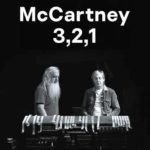“You up for listening to a little music?”
Rick Rubin is speaking to Paul McCartney. And with an affirmative answer in hand, the producer leads the Beatle – and viewers – through a six-episode, three-hour trip down Memory Lane titled McCartney 3, 2, 1.
Named for McCartney’s trilogy of true solo albums and executive produced by the principals, the film is nevertheless devoted almost exclusively to the Beatles, a band McCartney is now a fan of – not simply a former member – and Rubin is gaga for.
“When I say it was magical … we could’ve had five years and go back to the factory,” McCartney says at one point.
While three hours of two dudes listening to tunes and swapping stories on black-and-white film might seem like overkill, remember something: the Beatles are the only rock ‘n’ roll band that, with the exception of “Mr. Moonlight,” never recorded junk. (Though McCartney did record “Junk”).
Only in the last two episodes do things lag ever so slightly, as even the filmmakers seemed to get lazy, forgetting to edit out cameramen and crew who occasionally are seen lurking in the background.
Over the course of the film – streaming on Hulu and easily broken into bite-sized watch parties – McCartney gives away the inspiration for “Michelle” (pretending to be French to get chicks in the pre-Fab days) and “Sgt. Pepper,” which is how he misheard a crew member asking for salt and pepper.
Whether McCartney is bashing out song snippets on guitar and piano or the pair are pulling out various parts of tracks while leaning over a mixing board, McCartney 3, 2, 1 is like a flashlight in the Beatles’ attic.
Rubin focuses heavily on McCartney’s parts – “You can actually control the band with the bass,” the bassist says – but fans also hear “Yesterday” without strings; an alternate tape loop on “Tomorrow Never Knows;” weird, almost alien sounds mixed out of “Maybe I’m Amazed;” and some wildly off-key harmonies buried in “Lucy in the Sky with Diamonds.”
“This is why we don’t go into tape,” McCartney says when he hears it.
The contemporary studio footage occasionally cuts away to archival photos and videos and McCartney speaks lovingly of John Lennon, George Harrison, Ringo Starr and George Martin and the body of work they created. As the years rolled by, McCartney became as awed by it as everyone else.
“At the time, I was just working with this bloke, John,” he tells Rubin. “Now I look back and I was working with John Lennon.”
Three hours after it began, McCartney 3, 2, 1 ends with the titular musician showing Rubin how the final chord in “A Day in the Life” came to be. And the screen fades to black and “The End” begins to play.
It comes too soon.



No Comments comments associated with this post